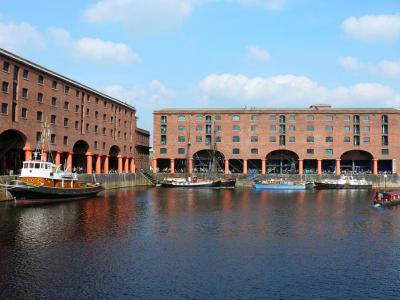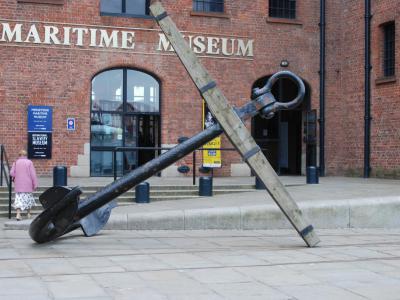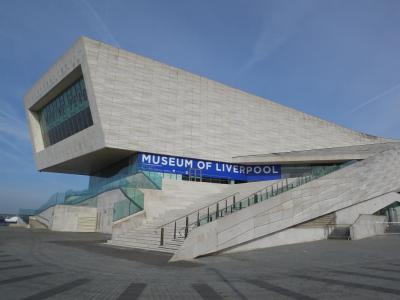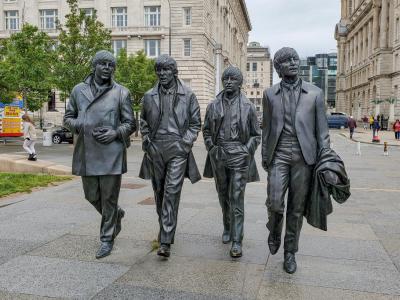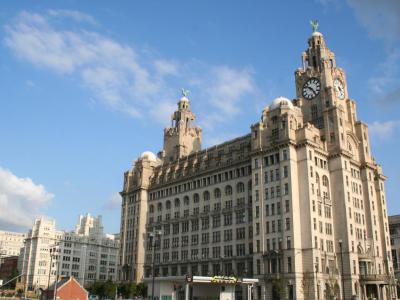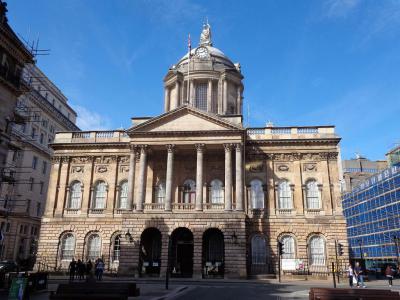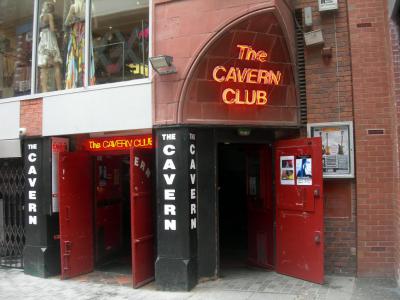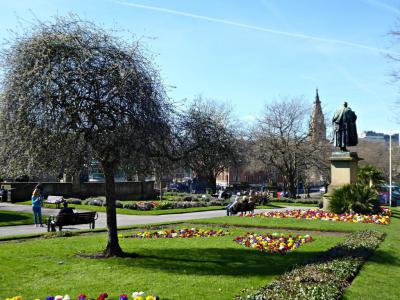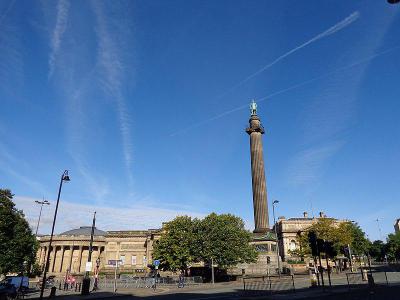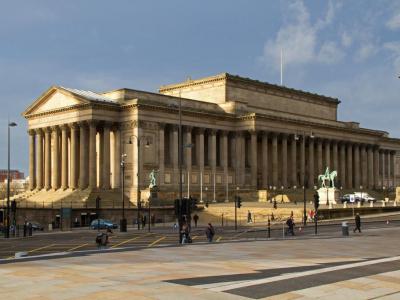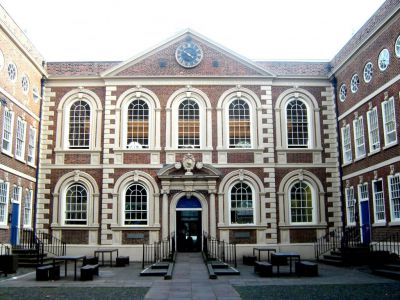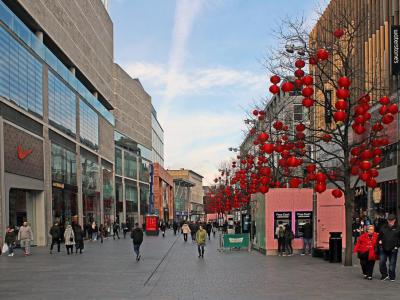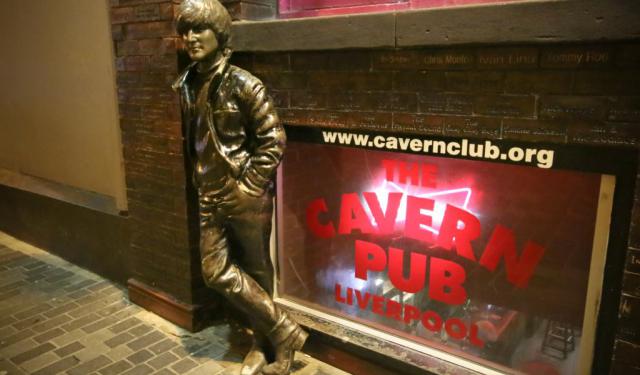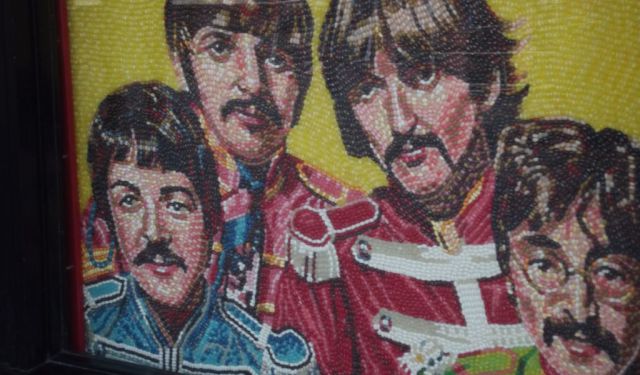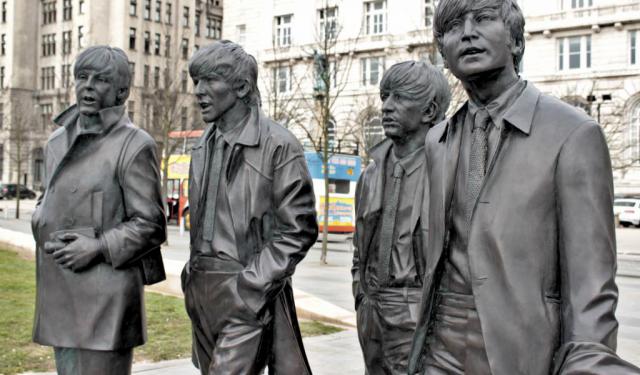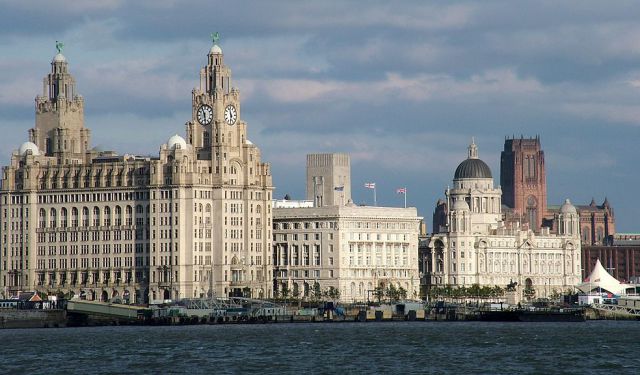
Liverpool Introduction Walking Tour (Self Guided), Liverpool
Famously, the hometown (aka the “capital”) of the Beatles, Liverpool is more than just the Fab Four. Closely associated with the arts, music, culture, and architecture, as well as industrial innovation, the city is renowned for its multitude of historic landmarks, world-class sport arenas and shopping/entertainment. The abundance of art galleries, national museums and listed attractions in Liverpool – the second highest number in the UK after London – is fit to delight culture lovers and history buffs. The strategical position of the city at the estuary of the Mersey, where the river meets the Irish Sea, determined its maritime past as a key trade and migration port.
The name “Liverpool” is believed to have come from the Old English “lifer”, meaning thick or muddy water, and “pōl”, meaning a pool or creek; although some suggest that it may have derived from "elverpool", a reference to the large number of eels in the Mersey, or from Welsh “llyvr pwl”, which means "expanse or confluence at the pool".
Although the borough of Liverpool was founded as early as 1207, by the mid 16th century, the local population accounted for some 500 people only, hindered by continued battles for control of the town waged during the English Civil War. In the early 18th century, amid the growing trade from the West Indies, Liverpool started to expand rapidly, with substantial profits from the slave trade and tobacco adding to its prosperity. For periods during the 19th century, because of the large volume of trade passing through the city, the wealth of Liverpool exceeded that of London and it was even described as "the New York of Europe". A good number of local landmarks, such as St George's Hall, Walker Art Gallery, Wellington's Column and others, emerged during the 1890s.
In the 1960s Liverpool was the center of the "Merseybeat" sound, which became synonymous with the Beatles, the most commercially successful and musically influential band in popular history. In 2004, several areas of the city center were granted World Heritage Site status by UNESCO including The Pier Head, home to the "Three Graces" – Royal Liver Building, Cunard Building and Port of Liverpool Building, as well as St George’s Quarter, home to the magnificent St George’s Hall, and more.
Capitalising on this popularity, tourism has become a significant factor in Liverpool's economy, rendering it the seventh most visited city in Britain. All of this makes Liverpool a highly attractive tourist destination. Follow this introduction walk to some of the key sights in Liverpool you wouldn't want to miss.
The name “Liverpool” is believed to have come from the Old English “lifer”, meaning thick or muddy water, and “pōl”, meaning a pool or creek; although some suggest that it may have derived from "elverpool", a reference to the large number of eels in the Mersey, or from Welsh “llyvr pwl”, which means "expanse or confluence at the pool".
Although the borough of Liverpool was founded as early as 1207, by the mid 16th century, the local population accounted for some 500 people only, hindered by continued battles for control of the town waged during the English Civil War. In the early 18th century, amid the growing trade from the West Indies, Liverpool started to expand rapidly, with substantial profits from the slave trade and tobacco adding to its prosperity. For periods during the 19th century, because of the large volume of trade passing through the city, the wealth of Liverpool exceeded that of London and it was even described as "the New York of Europe". A good number of local landmarks, such as St George's Hall, Walker Art Gallery, Wellington's Column and others, emerged during the 1890s.
In the 1960s Liverpool was the center of the "Merseybeat" sound, which became synonymous with the Beatles, the most commercially successful and musically influential band in popular history. In 2004, several areas of the city center were granted World Heritage Site status by UNESCO including The Pier Head, home to the "Three Graces" – Royal Liver Building, Cunard Building and Port of Liverpool Building, as well as St George’s Quarter, home to the magnificent St George’s Hall, and more.
Capitalising on this popularity, tourism has become a significant factor in Liverpool's economy, rendering it the seventh most visited city in Britain. All of this makes Liverpool a highly attractive tourist destination. Follow this introduction walk to some of the key sights in Liverpool you wouldn't want to miss.
How it works: Download the app "GPSmyCity: Walks in 1K+ Cities" from Apple App Store or Google Play Store to your mobile phone or tablet. The app turns your mobile device into a personal tour guide and its built-in GPS navigation functions guide you from one tour stop to next. The app works offline, so no data plan is needed when traveling abroad.
Liverpool Introduction Walking Tour Map
Guide Name: Liverpool Introduction Walking Tour
Guide Location: England » Liverpool (See other walking tours in Liverpool)
Guide Type: Self-guided Walking Tour (Sightseeing)
# of Attractions: 12
Tour Duration: 2 Hour(s)
Travel Distance: 3.6 Km or 2.2 Miles
Author: Caroline
Sight(s) Featured in This Guide:
Guide Location: England » Liverpool (See other walking tours in Liverpool)
Guide Type: Self-guided Walking Tour (Sightseeing)
# of Attractions: 12
Tour Duration: 2 Hour(s)
Travel Distance: 3.6 Km or 2.2 Miles
Author: Caroline
Sight(s) Featured in This Guide:
- Royal Albert Dock & the Waterfront
- Merseyside Maritime Museum
- Museum of Liverpool
- Beatles Statues
- Royal Liver Building
- Town Hall
- The Cavern Club
- St. John's Gardens
- Wellington's Column
- St. George's Hall
- The Bluecoat
- Liverpool One
1) Royal Albert Dock & the Waterfront (must see)
Albert Dock, a historic complex of docks and warehouses on the banks of the Mersey river, is Liverpool’s biggest tourist draw, attracting over 4 million visitors each year. It was built in the 1840s and designed by local architects Jesse Hartley and Philip Hardwick. The new dock was ground-breaking in two ways – one of the first dock complexes to allow direct unloading of cargo into warehouses, it was also the first UK development not to use wood in its construction. The complex was crucial to Liverpool’s rapid development as a global trade port, with ivory, sugar, silk and tobacco stored in its five vast warehouses.
The dock ceased to function for trade purposes after the outbreak of WWII, instead becoming a base for Royal Navy ships. In the post-war era, Albert Dock fell into disuse, before a redevelopment plan was drawn up in the 1980s. The dock itself was regenerated and hosted the Tall Ships Race in 1983, bringing a million tourists into the city. Gradually, the historic warehouses around the water were renovated and used for a wide range of new attractions. They now host a Maritime Museum, the world’s only dedicated Beatles museum, and Liverpool’s Tate Gallery.
Albert Dock houses the largest collection of Grade I listed buildings in the UK and is the jewel of Liverpool’s historic waterfront area. Immediately west of the dock, you will find the Pier Head, a peninsula jutting into the river which houses the Three Graces – three of Liverpool’s most famous buildings, including the Royal Liver building. The ornamental birds on the Liver building have become a symbol for the city’s university, council, and eponymous football team, Liverpool FC.
Why You Should Visit:
Industrial heritage, museums (some are free entry), art galleries, countless shops, bars & restaurants – a focal point of Liverpool.
The only problem with this place is, it is too big to discover in a single day.
The dock ceased to function for trade purposes after the outbreak of WWII, instead becoming a base for Royal Navy ships. In the post-war era, Albert Dock fell into disuse, before a redevelopment plan was drawn up in the 1980s. The dock itself was regenerated and hosted the Tall Ships Race in 1983, bringing a million tourists into the city. Gradually, the historic warehouses around the water were renovated and used for a wide range of new attractions. They now host a Maritime Museum, the world’s only dedicated Beatles museum, and Liverpool’s Tate Gallery.
Albert Dock houses the largest collection of Grade I listed buildings in the UK and is the jewel of Liverpool’s historic waterfront area. Immediately west of the dock, you will find the Pier Head, a peninsula jutting into the river which houses the Three Graces – three of Liverpool’s most famous buildings, including the Royal Liver building. The ornamental birds on the Liver building have become a symbol for the city’s university, council, and eponymous football team, Liverpool FC.
Why You Should Visit:
Industrial heritage, museums (some are free entry), art galleries, countless shops, bars & restaurants – a focal point of Liverpool.
The only problem with this place is, it is too big to discover in a single day.
2) Merseyside Maritime Museum (must see)
The city of Liverpool, and the surrounding county of Merseyside, both have a proud maritime museum. The region’s name comes from the River Mersey, a wide inlet from the Irish Sea which adjoins Liverpool. Access to the sea along the river allowed the city to become one of the world’s great trading ports during the Industrial Revolution. The Merseyside Maritime Museum is a celebration of Liverpool’s shipping history. It is located on Albert Dock, at the heart of Liverpool’s Mercantile Maritime City, an area of historic docklands that have been made a UNESCO World Heritage site.
The ground floor of the museum houses an exhibition on the shipping lines and companies that made Liverpool a global maritime trade centre. Other exhibitions show life in a port city in the modern day, including an interactive feature on Customs and Border Control, as well as a poignant tribute to the Titanic, the ocean liner which bore the city’s name on her doomed maiden voyage.
The museum also offers a range of child-friendly, nautically themed events throughout the year, as well as a guided tour of Liverpool’s Old Dock, which lies close to the building.
Why You Should Visit:
Engaging for both kids and adults with lots of interactive exhibits; a fantastic place to learn about Liverpool's maritime history.
Even if you view the ocean as little more than a scary, jellyfish-packed beach-separator, a visit to this nautical relic-fest is advised.
Tip:
On the ground floor, there are lockers to put belongings in to save you carrying bags and coats about.
If you find you have a spare hour, get booked in for an entertaining and informative guided tour.
Afterward, you can go to the top floor café (opens around noon), grab a drink or a bite and look out at the fantastic views of the docks and liver birds.
The ground floor of the museum houses an exhibition on the shipping lines and companies that made Liverpool a global maritime trade centre. Other exhibitions show life in a port city in the modern day, including an interactive feature on Customs and Border Control, as well as a poignant tribute to the Titanic, the ocean liner which bore the city’s name on her doomed maiden voyage.
The museum also offers a range of child-friendly, nautically themed events throughout the year, as well as a guided tour of Liverpool’s Old Dock, which lies close to the building.
Why You Should Visit:
Engaging for both kids and adults with lots of interactive exhibits; a fantastic place to learn about Liverpool's maritime history.
Even if you view the ocean as little more than a scary, jellyfish-packed beach-separator, a visit to this nautical relic-fest is advised.
Tip:
On the ground floor, there are lockers to put belongings in to save you carrying bags and coats about.
If you find you have a spare hour, get booked in for an entertaining and informative guided tour.
Afterward, you can go to the top floor café (opens around noon), grab a drink or a bite and look out at the fantastic views of the docks and liver birds.
3) Museum of Liverpool (must see)
The Museum of Liverpool is the newest addition to the National Museums Liverpool group, opened in 2011 replacing the former Museum of Liverpool Life. The intention is for the new venue to tell the story of Liverpool and its people, and reflect the city’s global significance. The museum is housed in a new purpose-built building on the Mann Island site at the Pier Head.
Exhibits from the entirety of National Museums Liverpool's collections are used for the Museum of Liverpool's displays. They tell the story of the city through items from collections of costume and decorative art, entomological and botanical collections and objects representing social and urban history, as well as oral testimonies, archaeological material, and photographic archives.
The Museum displays are divided into four main themes: The Great Port, Global City, People’s Republic, and Wondrous Place, located in four large gallery spaces. The Museum also features: Little Liverpool, a gallery for children under six; History Detectives, an interactive archaeology and history resource centre; a 180-seat theatre for community and audio-visual performances and meeting facilities. It also has a gallery called "City Soldiers" which tells the story of the King's Regiment.
Why You Should Visit:
Not only an outstanding piece of modernist design but also an amazing waterfront location, not to mention a surprising amount to learn about Liverpool's history.
Plus – helpful and friendly staff, gift shop, clean toilets on every floor, large affordable café, and even a separate room to use for indoor picnics when weather is poor.
Tip:
Use the lockers on the ground floor to save you having to carry any bags, then get the lift to the top floor so you can work our way down and not have to keep climbing stairs.
On the top floor, get into the exhibition room and walk straight till the end – there's a glass wall to enjoy the view of River Mersey and the Liver Building. The restrooms there have less of a queue, too.
Exhibits from the entirety of National Museums Liverpool's collections are used for the Museum of Liverpool's displays. They tell the story of the city through items from collections of costume and decorative art, entomological and botanical collections and objects representing social and urban history, as well as oral testimonies, archaeological material, and photographic archives.
The Museum displays are divided into four main themes: The Great Port, Global City, People’s Republic, and Wondrous Place, located in four large gallery spaces. The Museum also features: Little Liverpool, a gallery for children under six; History Detectives, an interactive archaeology and history resource centre; a 180-seat theatre for community and audio-visual performances and meeting facilities. It also has a gallery called "City Soldiers" which tells the story of the King's Regiment.
Why You Should Visit:
Not only an outstanding piece of modernist design but also an amazing waterfront location, not to mention a surprising amount to learn about Liverpool's history.
Plus – helpful and friendly staff, gift shop, clean toilets on every floor, large affordable café, and even a separate room to use for indoor picnics when weather is poor.
Tip:
Use the lockers on the ground floor to save you having to carry any bags, then get the lift to the top floor so you can work our way down and not have to keep climbing stairs.
On the top floor, get into the exhibition room and walk straight till the end – there's a glass wall to enjoy the view of River Mersey and the Liver Building. The restrooms there have less of a queue, too.
Sight description based on Wikipedia.
4) Beatles Statues (must see)
This larger than life statue of the Beatles, located right in front of the Liver Building on the Waterfront, is a great place for a photo stop for the Beatles fans. If looked at closely, each member of the band displays a small personal detail.
- Paul McCartney carries a camera on his back, which may be a subtle hint to his relationship with Linda Eastman.
- John Lennon has two acorns in his hand. Yoko Ono and John Lennon planted two acorns in the garden of Coventry Cathedral in 1968 as their wish for world peace.
- Ringo Starr's boot has the number ‘8’ on it, which may be the size of the shoes he wears.
- George Harrison has Sanskrit written on his belt.
The Beatles statue is the city's most popular selfie spot!
- Paul McCartney carries a camera on his back, which may be a subtle hint to his relationship with Linda Eastman.
- John Lennon has two acorns in his hand. Yoko Ono and John Lennon planted two acorns in the garden of Coventry Cathedral in 1968 as their wish for world peace.
- Ringo Starr's boot has the number ‘8’ on it, which may be the size of the shoes he wears.
- George Harrison has Sanskrit written on his belt.
The Beatles statue is the city's most popular selfie spot!
5) Royal Liver Building
The Royal Liver Building is located at the Pier Head and, along with the neighbouring Cunard Building and Port of Liverpool Building, is one of Liverpool's Three Graces, which line the city's famous and iconic waterfront. A Grade I listed building, it is also part of Liverpool's UNESCO-designated World Heritage Maritime Mercantile City.
One of the first structures in the world to be built using reinforced concrete, the Royal Liver Building stands at 98.2 m (322 ft) tall to the top of the spires, and 50.9 m (167 ft) to the main roof. Opened in 1911 (three years before World War I), it was the largest building in Europe up until the mid-thirties. It is now, however, only the joint-fourth tallest structure in the City of Liverpool, having been overtaken in height by West Tower, Radio City Tower and Liverpool Cathedral.
The Royal Liver Building remains one of the most recognisable landmarks in the city of Liverpool and is home to two fabled Liver Birds that watch over the city and the sea. Legend has it that were these two birds to fly away, then the city would cease to exist.
Why You Should Visit:
In September 2019, during the UK Heritage Open Days, for the first time in its 100+ year history, the Royal Liver Building unlocked its doors to the public with the launch of Royal Liver Building 360, a brand new fully guided tower tour offering a world class audio visual experience complete with panoramic 360° views across Liverpool from the 15th floor viewing platform – a true ‘bucket list’ must-see attraction.
Tip:
Guided tours take around 70 minutes, with each group limited to 14 people to ensure that everyone gets a great view and the chance to capture images. Visitors are allowed access to all areas inside and outside of the building – from the marble lobby to the roof and a climb up the "chicken stairway" under the Liver Bird cupola. Yes, you can climb to as high as it gets and it is a quite incredible, unique experience, but in order to get tickets, you need to book well in advance.
Before booking tickets, prospective visitors should note that the tour is physically demanding and requires the negotiation of 124 steps, 71 of which are a narrow spiral stone staircase. The tour is also not open to children under seven years of age.
One of the first structures in the world to be built using reinforced concrete, the Royal Liver Building stands at 98.2 m (322 ft) tall to the top of the spires, and 50.9 m (167 ft) to the main roof. Opened in 1911 (three years before World War I), it was the largest building in Europe up until the mid-thirties. It is now, however, only the joint-fourth tallest structure in the City of Liverpool, having been overtaken in height by West Tower, Radio City Tower and Liverpool Cathedral.
The Royal Liver Building remains one of the most recognisable landmarks in the city of Liverpool and is home to two fabled Liver Birds that watch over the city and the sea. Legend has it that were these two birds to fly away, then the city would cease to exist.
Why You Should Visit:
In September 2019, during the UK Heritage Open Days, for the first time in its 100+ year history, the Royal Liver Building unlocked its doors to the public with the launch of Royal Liver Building 360, a brand new fully guided tower tour offering a world class audio visual experience complete with panoramic 360° views across Liverpool from the 15th floor viewing platform – a true ‘bucket list’ must-see attraction.
Tip:
Guided tours take around 70 minutes, with each group limited to 14 people to ensure that everyone gets a great view and the chance to capture images. Visitors are allowed access to all areas inside and outside of the building – from the marble lobby to the roof and a climb up the "chicken stairway" under the Liver Bird cupola. Yes, you can climb to as high as it gets and it is a quite incredible, unique experience, but in order to get tickets, you need to book well in advance.
Before booking tickets, prospective visitors should note that the tour is physically demanding and requires the negotiation of 124 steps, 71 of which are a narrow spiral stone staircase. The tour is also not open to children under seven years of age.
Sight description based on Wikipedia.
6) Town Hall
Liverpool Town Hall was built between 1749 and 1754 according to a design by John Wood the Elder. An extension to the north, designed by James Wyatt, was added in 1785. The town hall is built of stone with a slate roof and a lead dome. The building has two storeys and a basement; the stonework of the basement and lower storey is rusticated. The south face has nine bays. Its central three bays are occupied by the portico. This has three rounded arches on the ground floor, and four pairs of Corinthian columns surrounding a balcony. Above the upper storey windows on all faces are panels containing carvings.
The dome stands on a high drum supported on columns. Around the base of the dome are four clock faces, each of which is supported by a lion and unicorn. On the summit of the dome is a statue, representing Minerva. It is a Grade I listed building, described in Images of England as "one of the finest surviving 18th-century town halls".
Why You Should Visit:
Inside, visitors will find the grandest suite of civic rooms in the UK and a magnificent example of late Georgian decoration.
You also might want to go onto the balcony where the Beatles stood when returned to Liverpool.
Tip:
Guided tours inside are available, but check the opening times prior to visit or just take photos from the Castle Street.
Once the main business district, the area is now replete with bars and restaurants, so refreshments are only minutes away/opposite.
The dome stands on a high drum supported on columns. Around the base of the dome are four clock faces, each of which is supported by a lion and unicorn. On the summit of the dome is a statue, representing Minerva. It is a Grade I listed building, described in Images of England as "one of the finest surviving 18th-century town halls".
Why You Should Visit:
Inside, visitors will find the grandest suite of civic rooms in the UK and a magnificent example of late Georgian decoration.
You also might want to go onto the balcony where the Beatles stood when returned to Liverpool.
Tip:
Guided tours inside are available, but check the opening times prior to visit or just take photos from the Castle Street.
Once the main business district, the area is now replete with bars and restaurants, so refreshments are only minutes away/opposite.
Sight description based on Wikipedia.
7) The Cavern Club (must see)
Opened on 16 January 1957 as a jazz club and later becoming a center of Liverpool's rock-and-roll scene in the early 1960s, the Cavern Club became closely associated with the Merseybeat music genre and, famously, regularly played host to The Beatles in their early years, initially as part of the weekday "beat sessions" at lunchtime.
The Beatles made their first appearance at the club after returning to Liverpool from Hamburg, Germany where they had been playing at the Indra and the Kaiserkeller clubs. There and then, on Tuesday, February 9, 1961, they were signed up as the club's resident lunchtime group, working in alternation with Gerry and the Pacemakers. Narrow, cobbled, uneventful Mathew Street thus began to lead an unexpected new life in daylight hours. At noon, Mondays to Fridays, a four-abreast line would begin to form at the Cavern's hatchlike entrance, growing by the minute until it stretched back past the warehouses and delivery trucks and piled-up fruit crates, eighty-odd yards to the junction with Whitechapel. Inside, there was no "security" whatsoever, and no alcohol was sold either at lunchtimes or at night, only coffee and soft drinks.
From 1961 to 1963, the Beatles made 292 appearances at The Cavern. By summer of 1963, "Beatlemania" was sprouting across England, and with girls demanding to see the Beatles and screaming just to get a glimpse of them, the group had to hide or sneak into concerts, and the small club could no longer satisfy audience demand. So on 3 August 1963, the Beatles made their final appearance at The Cavern.
In the decade that followed, a wide variety of popular acts appeared at the club, including The Rolling Stones, The Yardbirds, The Hollies, The Kinks, Elton John, Black Sabbath, Queen, The Who, and John Lee Hooker.
Even if you're not that bothered about the Beatles, The Cavern is a must-visit experience when in Liverpool. The live music is still brilliant, and the door charge of £2.50 per person after noon is not much to pay for such a historic place.
Why You Should Visit:
To check out the most legendary cellar club on the planet that has been the beating heart of Liverpool’s iconic music scene for over seven decades, visited by millions of people from all over the world passing down its famous stairway.
The Beatles made their first appearance at the club after returning to Liverpool from Hamburg, Germany where they had been playing at the Indra and the Kaiserkeller clubs. There and then, on Tuesday, February 9, 1961, they were signed up as the club's resident lunchtime group, working in alternation with Gerry and the Pacemakers. Narrow, cobbled, uneventful Mathew Street thus began to lead an unexpected new life in daylight hours. At noon, Mondays to Fridays, a four-abreast line would begin to form at the Cavern's hatchlike entrance, growing by the minute until it stretched back past the warehouses and delivery trucks and piled-up fruit crates, eighty-odd yards to the junction with Whitechapel. Inside, there was no "security" whatsoever, and no alcohol was sold either at lunchtimes or at night, only coffee and soft drinks.
From 1961 to 1963, the Beatles made 292 appearances at The Cavern. By summer of 1963, "Beatlemania" was sprouting across England, and with girls demanding to see the Beatles and screaming just to get a glimpse of them, the group had to hide or sneak into concerts, and the small club could no longer satisfy audience demand. So on 3 August 1963, the Beatles made their final appearance at The Cavern.
In the decade that followed, a wide variety of popular acts appeared at the club, including The Rolling Stones, The Yardbirds, The Hollies, The Kinks, Elton John, Black Sabbath, Queen, The Who, and John Lee Hooker.
Even if you're not that bothered about the Beatles, The Cavern is a must-visit experience when in Liverpool. The live music is still brilliant, and the door charge of £2.50 per person after noon is not much to pay for such a historic place.
Why You Should Visit:
To check out the most legendary cellar club on the planet that has been the beating heart of Liverpool’s iconic music scene for over seven decades, visited by millions of people from all over the world passing down its famous stairway.
8) St. John's Gardens
St. John’s Gardens are an area of public park land close to William Brown Street, in Liverpool’s city centre. One of two parks within Liverpool’s World Heritage Site, they are bordered to the east by St. George’s Hall, a fine Neoclassical building which houses law courts and a concert venue. The Green Flag awarded gardens house ornamental shrubs and flower beds, as well as a number of memorials to the city’s famous citizens. These include statues of Liverpool University founder William Rathbone and former British prime minister W.E. Gladstone.
The spot of land, on which St. John’s Gardens now stand, has had a chequered history. Once an area of heath land, known as the Great Heath, the land was swallowed up by Liverpool’s rapid development in the Victorian era. Through the intervening years, it has housed the city’s first hospital, a naval infirmary, an asylum and a range of industries – including potteries, windmills and a marble yard. The site also housed a church (St. John the Baptist) and a cemetery until the church was demolished in 1898. Six years later, the cemetery was relocated, and the land was redeveloped into ornamental gardens by Thomas Shelmerdine, who also designed the nearby Hornby Library.
The spot of land, on which St. John’s Gardens now stand, has had a chequered history. Once an area of heath land, known as the Great Heath, the land was swallowed up by Liverpool’s rapid development in the Victorian era. Through the intervening years, it has housed the city’s first hospital, a naval infirmary, an asylum and a range of industries – including potteries, windmills and a marble yard. The site also housed a church (St. John the Baptist) and a cemetery until the church was demolished in 1898. Six years later, the cemetery was relocated, and the land was redeveloped into ornamental gardens by Thomas Shelmerdine, who also designed the nearby Hornby Library.
9) Wellington's Column
Wellington’s Column is a towering memorial to the Duke of Wellington, located on William Brown Street in the historic heart of Liverpool city centre. Commissioned after the Duke’s death in 1852, it is the work of two Scottish siblings – Andrew Lawson, who designed the Greek style column, and his brother George, who created the statue of Wellington. It was one of the last column monuments to be erected in the UK, largely because of lengthy delays in its construction. Wellington’s Column was eventually completed in 1865.
Built from stone sourced at local quarries in Runcorn and Darley Dale, the column is 81 feet high. The statue of Wellington, said to be cast in bronze taken from the cannons used at the Battle of Waterloo, is facing to the southeast, towards the Belgian fields where Wellington claimed his most famous victory. Brass plaques at the base of the monument list the Duke’s many military victories, as well as a relief of the final charge at Waterloo.
The style and scale of the monument draw obvious comparisons with one of the UK’s most famous landmarks, Nelson’s Column. Wellington’s Monument measures 132 feet in total, just 30 feet shorter than its London counterpart. Full details of the measurements of this impressive feat of engineering can be found around the base of the column.
Why You Should Visit:
Unfortunately, visitors can’t climb to the top of the column, but it is an impressive part of Liverpool’s museum quarter, nevertheless.
Built from stone sourced at local quarries in Runcorn and Darley Dale, the column is 81 feet high. The statue of Wellington, said to be cast in bronze taken from the cannons used at the Battle of Waterloo, is facing to the southeast, towards the Belgian fields where Wellington claimed his most famous victory. Brass plaques at the base of the monument list the Duke’s many military victories, as well as a relief of the final charge at Waterloo.
The style and scale of the monument draw obvious comparisons with one of the UK’s most famous landmarks, Nelson’s Column. Wellington’s Monument measures 132 feet in total, just 30 feet shorter than its London counterpart. Full details of the measurements of this impressive feat of engineering can be found around the base of the column.
Why You Should Visit:
Unfortunately, visitors can’t climb to the top of the column, but it is an impressive part of Liverpool’s museum quarter, nevertheless.
10) St. George's Hall (must see)
Considered as one of the finest neo-Grecian buildings in the world, St George's Hall is a great example of Liverpool's neoclassical architecture. This Grade I listed building's Greek-columned facade is both impressive and imposing. The St. George's Hall hosts social events, including live music, and is open for visitors free of charge. Also, you can also book a guided tour online and be greeted by the friendliest of guides welcoming you to spend well a few hours inside.
The main entrance is in the centre of the east façade and is approached by a wide flight of steps. The front has a central portico of 16 Corinthian columns flanked on each side by series of square pillars. Between these pillars are reliefs which were added between 1882 and 1901. The roof is a tunnel vault carried on columns of polished red granite. The walls have niches for statues and the panelled plasterwork of the vault has allegorical figures of Virtues, Science and Arts.
The highly decorated floor consists of 30,000 Minton tiles. The doors are bronze and have openwork panels which incorporate the letters SPQL (the Senate and the People of Liverpool) making an association with ancient Rome. The organ is at the north end and at the south end is a round arch supporting an entablature between whose columns is a gate leading directly into the Crown Court. The building also houses the world's first air-conditioning system from Victorian times.
Why You Should Visit:
Wonderful architecture from a time when bureaucracy knew that, if they were going to keep you waiting half an hour to fill in a form, then it may as well be somewhere nice!
Tip:
Try and find out when the original tile flooring is on show, as that is a perfect time to go (doesn't happen very often).
Don't miss the coffee shop on the ground floor – superb value and quite reasonably priced and atmospheric.
The main entrance is in the centre of the east façade and is approached by a wide flight of steps. The front has a central portico of 16 Corinthian columns flanked on each side by series of square pillars. Between these pillars are reliefs which were added between 1882 and 1901. The roof is a tunnel vault carried on columns of polished red granite. The walls have niches for statues and the panelled plasterwork of the vault has allegorical figures of Virtues, Science and Arts.
The highly decorated floor consists of 30,000 Minton tiles. The doors are bronze and have openwork panels which incorporate the letters SPQL (the Senate and the People of Liverpool) making an association with ancient Rome. The organ is at the north end and at the south end is a round arch supporting an entablature between whose columns is a gate leading directly into the Crown Court. The building also houses the world's first air-conditioning system from Victorian times.
Why You Should Visit:
Wonderful architecture from a time when bureaucracy knew that, if they were going to keep you waiting half an hour to fill in a form, then it may as well be somewhere nice!
Tip:
Try and find out when the original tile flooring is on show, as that is a perfect time to go (doesn't happen very often).
Don't miss the coffee shop on the ground floor – superb value and quite reasonably priced and atmospheric.
Sight description based on Wikipedia.
11) The Bluecoat
Built in 1716-17 as a charity school, Bluecoat Chambers in School Lane is the oldest surviving building in central Liverpool. Following the Liverpool Blue Coat School's move to another site in 1906, the building was rented from 1907 onwards by the Sandon Studios Society. Based on the presence of this art society and the subsequent formation of the Bluecoat Society of Arts in 1927, the successor organisation laid claim to being the oldest arts centre in Great Britain, now called The Bluecoat.
The centre offers a full program of events and exhibitions including art, film, and performances, and explains why Liverpool was European Capital of Culture in 2008. One of those places where local artists (writers, musicians, etc.) have an opportunity to show their art and where tourists can enjoy the cultural richness of a city that is full of artistic reminiscences both old and current. To enhance the experience, visit Kernaghan Bookshop which is located in the courtyard is a bookworm's dream. The espresso bar serves coffees and cakes, while the upstairs bistro provides more hearty fare (their delicious scouse is a must try for anyone visiting Liverpool). Come for the coffee, stay for the events!
Why You Should Visit:
Very relaxing place to have a drink or a snack; fully recommended in nice weather so you can sit outside and just relax!
Great venue if you're looking for somewhere that little bit more special than other places you may be considering.
The centre offers a full program of events and exhibitions including art, film, and performances, and explains why Liverpool was European Capital of Culture in 2008. One of those places where local artists (writers, musicians, etc.) have an opportunity to show their art and where tourists can enjoy the cultural richness of a city that is full of artistic reminiscences both old and current. To enhance the experience, visit Kernaghan Bookshop which is located in the courtyard is a bookworm's dream. The espresso bar serves coffees and cakes, while the upstairs bistro provides more hearty fare (their delicious scouse is a must try for anyone visiting Liverpool). Come for the coffee, stay for the events!
Why You Should Visit:
Very relaxing place to have a drink or a snack; fully recommended in nice weather so you can sit outside and just relax!
Great venue if you're looking for somewhere that little bit more special than other places you may be considering.
Sight description based on Wikipedia.
12) Liverpool One
Liverpool ONE is a shopping, residential and leisure complex in Liverpool city center. The shopping center, anchored by department stores Debenhams and John Lewis, offers over 170 stores, bars and restaurants with additional leisure facilities such as a 14-screen Odeon cinema, a 36-hole adventure golf center, and public open space. Liverpool ONE is the largest open-air shopping center in the United Kingdom and the 6th largest overall. Each store was created by a different architect, thereby leading to quite stark differences between some buildings, and this is one way in which Liverpool ONE differentiates itself from other shopping centers.
Liverpool ONE is also a great place for fine dining in the city. With over 35 restaurants serving both local and international cuisines, you will have ample dining selections to choose from.
Liverpool ONE is also a great place for fine dining in the city. With over 35 restaurants serving both local and international cuisines, you will have ample dining selections to choose from.
Walking Tours in Liverpool, England
Create Your Own Walk in Liverpool
Creating your own self-guided walk in Liverpool is easy and fun. Choose the city attractions that you want to see and a walk route map will be created just for you. You can even set your hotel as the start point of the walk.
Beatles Tour in Liverpool, Part III
Now that you have been to a good number of spots around Liverpool associated with The Beatles, it is high time to explore the “early days” of the Fab Four in their hometown and see where it all started.
One such place is Strawberry Field, immortalized in their song "Strawberry Fields Forever." It was a Salvation Army children's home, and although the original building no... view more
Tour Duration: 2 Hour(s)
Travel Distance: 5.3 Km or 3.3 Miles
One such place is Strawberry Field, immortalized in their song "Strawberry Fields Forever." It was a Salvation Army children's home, and although the original building no... view more
Tour Duration: 2 Hour(s)
Travel Distance: 5.3 Km or 3.3 Miles
Beatles Pub Crawl
Alright, so you're in Liverpool, the hometown of The Beatles, and you're thirsty. There are lots of pubs in Liverpool, all different in character, with some claiming that The Beatles drank or played there at some point.
Indeed, the lads performed in many small venues throughout the city, but the joints they usually played were not the ones they liked for their drinks. Now, if... view more
Tour Duration: 1 Hour(s)
Travel Distance: 1.8 Km or 1.1 Miles
Indeed, the lads performed in many small venues throughout the city, but the joints they usually played were not the ones they liked for their drinks. Now, if... view more
Tour Duration: 1 Hour(s)
Travel Distance: 1.8 Km or 1.1 Miles
Beatles Tour in Liverpool, Part II
Liverpool is permeated with The Beatles who seem to be everywhere! There are so many places associated with the band in the city: childhood homes, schools, bars... Some of them are rather unassuming, at a glance, and thus can be easily overlooked.
George Harrison's Birthplace, located at 12 Arnold Grove, is where the lead guitarist of The Beatles was born on February 25, 1943. Despite its... view more
Tour Duration: 2 Hour(s)
Travel Distance: 4.1 Km or 2.5 Miles
George Harrison's Birthplace, located at 12 Arnold Grove, is where the lead guitarist of The Beatles was born on February 25, 1943. Despite its... view more
Tour Duration: 2 Hour(s)
Travel Distance: 4.1 Km or 2.5 Miles
Liverpool Historical Sites Walking Tour
For a city steeped in history and culture as much as Liverpool, it is only natural to have many historical sites illustrative of its glorious past. Three of Liverpool's most remarkable buildings, collectively known as the Three Graces of Liverpool, are situated in the Pier Head. These include the Royal Liver Building, the Cunard Building, and the Port of Liverpool Building.
The... view more
Tour Duration: 1 Hour(s)
Travel Distance: 1.3 Km or 0.8 Miles
The... view more
Tour Duration: 1 Hour(s)
Travel Distance: 1.3 Km or 0.8 Miles
Beatles Tour in Liverpool, Part I
The hometown of Paul McCartney, John Lennon, George Harrison, and Ringo Star, Liverpool is called “The Beatles Capital” for a reason. The city saw the dawn of the Fabulous Four's musical career and is brimming with Beatlemania: Beatles-themed bars, restaurants, hotels, and other places associated with the iconic band.
The Beatles Story, an immersive museum, chronicles the Fab... view more
Tour Duration: 2 Hour(s)
Travel Distance: 3.4 Km or 2.1 Miles
The Beatles Story, an immersive museum, chronicles the Fab... view more
Tour Duration: 2 Hour(s)
Travel Distance: 3.4 Km or 2.1 Miles
The Most Popular Cities
/ view all
